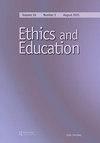Editorial: pedagogical forms in times of pandemic
IF 0.7
Q3 EDUCATION & EDUCATIONAL RESEARCH
引用次数: 0
Abstract
Special Issue in Ethics & Education Pedagogical Forms in Times of Pandemic With the outbreak of the COVID-19 virus in the Spring 2020, campus life came to a halt. In many places all over the world, physical on campus seminars and lectures – pedagogical forms that prior to the outbreak of the pandemic were part of the very DNA of university life – could no longer take place like before and had to be either strictly regulated in terms of space and safety or simply converted into other forms. The loss of human togetherness and the reduction of teaching to a uniform activity on a flat digital screen (in wealthier parts of the world) echoed the sensory losses that were symptoms of the virus infection itself, turning the art of teaching almost from one day to the next into a twodimensional and sterile experience. Even if the prefix pan indicated that the global spread of the COVID-19 virus equally affected people all over the world, there were profound differences to be recognized. On local level, the pandemic magnified deep-rooted gendered, racial, economic, and social injustices, exposing perpetuated inequities particularly within the realm of education. In some contexts, schools were shut down and the children sent home, literally losing their education because of the pandemic. In others, the digital divide became a chasm, separating those who had access to electricity, computers, and the Internet from those who did not.社论:大流行时期的教学形式
大流行病时期的伦理学与教育教学形式特刊随着新冠肺炎病毒在2020年春季爆发,校园生活陷入停滞。在世界各地的许多地方,物理校园研讨会和讲座——在疫情爆发之前是大学生活DNA的一部分的教学形式——不能再像以前那样进行了,必须在空间和安全方面受到严格监管,或者简单地转换成其他形式。人类失去了团结,教学减少到在平面数字屏幕上进行统一的活动(在世界上较富裕的地区),这与病毒感染本身的症状——感官丧失相呼应,使教学艺术几乎从一天到下一天变成了一种二维的、无菌的体验。即使前缀pan表示新冠肺炎病毒的全球传播同样影响到世界各地的人们,但仍存在着深刻的差异需要认识。在地方一级,疫情加剧了根深蒂固的性别、种族、经济和社会不公正,暴露了长期存在的不平等,尤其是在教育领域。在某些情况下,学校被关闭,孩子们被送回家,实际上因为疫情而失去了教育。在另一些国家,数字鸿沟成为了一道鸿沟,将那些有电、电脑和互联网的人与那些没有电、电脑或互联网的人分隔开来。
本文章由计算机程序翻译,如有差异,请以英文原文为准。
求助全文
约1分钟内获得全文
求助全文

 求助内容:
求助内容: 应助结果提醒方式:
应助结果提醒方式:


